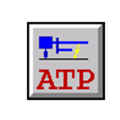

Design of Power Networks
Design and Simulation of Electrical Power Networks
The power network will be calculated with ATP, the Alternative Transients Program. ATP-EMTP as world-wide mostly used universal program for digital simulation of electromagnetic transients in power systems has extensive modeling capabilities. The network simulation system ATP is designed and will be further developed to simulate single- and multi-phase electrical power networks. ATP is very well prepared to calculate voltages and currents of 3-phase electrical power networks. It can be used to simulate high-frequency transient phenomena as well as stationary short circuits. In addition ATP supports a lot of network elements, linear and nonlinear impedances and mathematical methods to design a model of the electrical power network.
Various Network Elements e.g. overhead lines or transformers are prepared as templates and can be used very easy to design electrical 3-phase and 1-phase power networks. All network elements are defined from the electrical engineering point of view. The knowledge of the geometrical and physical data of the network elements are sufficient to define the required settings. Internal, only ATP related settings are predefined and invisible for the ATPDesigner user. Neither detailed knowledge in modeling power network elements nor detailled knowledge about ATP and the ATP rules are required, if ATPDesigner will be used as the graphical user interface.
- Simulation of 3-Phase Power Networks
- Short-Circuit Analysis of 3-Phase Power Networks
- Simulation of 1-Phase Networks
Various Network Elements e.g. overhead lines or transformers are prepared as templates and can be used very easy to design electrical 3-phase and 1-phase power networks. All network elements are defined from the electrical engineering point of view. The knowledge of the geometrical and physical data of the network elements are sufficient to define the required settings. Internal, only ATP related settings are predefined and invisible for the ATPDesigner user. Neither detailed knowledge in modeling power network elements nor detailled knowledge about ATP and the ATP rules are required, if ATPDesigner will be used as the graphical user interface.
Linear Network Elements
- Impedances (RLC)
- Overhead Lines (Single-Circuit Lines, Double-Circuit Lines, etc.)
- Transposed and Untransposed Lines
- Cables
- Transformers (2 Winding, 3 Winding, etc.)
- Circuit Breakers
- Generators
- Rotating Machines
- etc.
Non-Linear Network Elements
- Static and Dynamic Arc Resistances
- CT Saturation with Hysteresis
- Overfluxing
- MOV (Metal Oxide Varistor)
- etc.
Additional Properties
- Transient Analysis of Control Systems (TACS)
- Filter Techniques
- Laplace Functions
- Free Programmable Interface (MODELS)
- etc.